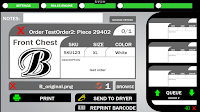What an amazing whirlwind of a year. New technology and innovation moved Brown and BrownDigital into new segments of the garment decorating industry. This addition brings new energy and enthusiasm to existing projects as well.
So what's new?
That's a big question. Around our facility it feels like everything is new. New curing systems, new printing technology and completely new product lines.
Expanded Anaconda™
The Anaconda system is a flat heater that combines with a roller in an automatic printer to flatten fibers into ink to create a smoother print surface and, hence, brighter prints. Originally, this was developed to use a 23" x 31" M3 roller frame support platform to fit into an standard automatic textile printer, like our ElectraPrint Stealth. The excitement for the Anaconda has grown and we expanded the possible press sizes for it. Now it can be mounted on a 21" x 24" MZX roller frame support which allows it to fit into smaller automatic presses like our ElectraPrint Junior.
The creativity of our customers as to how this product can benefit production is exciting. We see the Anaconda applied to prints on polyester with dye migration issues, on water base or discharge inks to activate the cure and smooth out the print and on fibrous shirts for a crisper finished print. The options are exciting.
The creativity of our customers as to how this product can benefit production is exciting. We see the Anaconda applied to prints on polyester with dye migration issues, on water base or discharge inks to activate the cure and smooth out the print and on fibrous shirts for a crisper finished print. The options are exciting.
Synergy™ pretreat system
BrownDigital moved deeper into the world of direct to garment printing. The Synergy pretreat module system is a high production pretreated that ties directly into the FireFly™. This unit offers more features and sprays pretreat more evenly and at higher speeds than competitive machines. The exciting connection to the Brother GTX line of printers allows for pod style production growth with minimal labor costs. Check out our recent blog about these pod systems.
This system also puts more information in front of the garment loader. There is always a concern that what is pretreated is not the correct garment for the required order. The projection system that is included with the Synergy displays an image of the shirt required and the image that is to be printed. This gives confirmation to the operator that the are loading the correct product. Features like this make this the leader in pretreat technology.
This system also puts more information in front of the garment loader. There is always a concern that what is pretreated is not the correct garment for the required order. The projection system that is included with the Synergy displays an image of the shirt required and the image that is to be printed. This gives confirmation to the operator that the are loading the correct product. Features like this make this the leader in pretreat technology.
Linx™ Control System Integration
What is Control System Integration? It is complete production software that ties your orders to your pretreat, digital printer and shipping software. A barcode control system allows for inventory control and complete tracking of goods within your production facility and into shipping. This product has quietly expanded and is running in facilities throughout the US. BrownDigital views this as an essential component to online sales and digital printing. This is a lead off for 2018 and it is an exciting direction for our corporate growth.
Brown Mfg and BrownDigital are looking forward to 2018. The expansion of market areas from our existing product line and the development of new items is exciting. Keep watching this blog for updates.




























